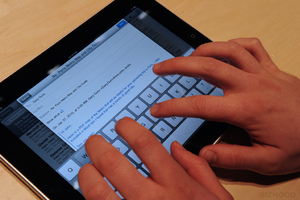 Ooooooh. Or eeewwwwwwww? Photo by Matt Buchanan. Licensed under CC 2.0.
Ooooooh. Or eeewwwwwwww? Photo by Matt Buchanan. Licensed under CC 2.0.It's fair to say these days that students love Apple. The MacBook outsells every other laptop out there n the student demographic. The iPhone is the go-to smart phone for students: the $99 entry point is affordable and you can leave your parents with the monthly bill. Apple tried once again to explode the world today with the announcement of the iPad, the mythical Apple tablet. Unlike unicorns, these actually exist. There are many features on this thing, but I'm going to highlight the ones that will be particularly applicable to a student's lifestyle.
So what does the iPad mean for students?
The Netbook You Wish You Bought, Question Mark?
Mr. Steve Jobs started off his keynote this morning by calling netbooks chinsy. They aren't so much netbooks as they are cheap laptops. What the world needs instead, Steve argued, was something else to fit into this "third space." (The third space is the category between laptop and phone.)
We've been big proponents of netbooks in the past, and the fact that Stevie specifically called out netbooks made my ears perk up. Maybe the netbook isn't for that middle space, but a tablet? Maybe we weren't meant to wrestle with small physical keyboards but rather small virtual keyboards? Is this the Jesus netbook?
Maybe. I won't be able to answer this specific question until I have one in my lap for a week.
iBook Store
I'm a Kindle owner and we reviewed a ton of eBook readers at CES. Hell, I'm trying to go the entire semester with solely digital material.
A few of the best things about the Kindle are its screen DPI (dots per inch), its contrast ratio and its "inactive" screen. The DPI doesn't determine the resolution of a screen, but rather how densely packed together the pixels are. Your typical computer screen these days has a DPI of 72. The Kindle 2's DPI is closer to 160. The higher DPI makes anything displayed on the screen appear crisper.
The contrast ratio is similar. Pitch black ink on paper has an extremely high contrast ratio. eInk screens do their best to replicate this contrast ratio and do a pretty good job. With active LCD screens, it's a little bit tougher to get high contrast ratios. This is one thing that can contribute eye strain during long sessions in front of a screen.
The Kindle's inactive screen is also a plus. The device refreshes the screen at every page turn. A typical computer screen is actually blinking 60 times per second. Any person that has stared into a strobe light knows that this can be uncomfortable. (Thankfully, I am completely immune to such flicker sickness.)
While I think the iPad will be the Kindle hands down for flipping through textbooks, I bet I will still prefer my Kindle for casual and longer reading sessions.
iWork
One of my favorite academic-related pieces of software is Keynote. I create all of my presentations in Keynote. One of the best parts about Keynote is that it makes it easy to create good presentations. Open Office and PowerPoint can do the same things as Keynote, but it takes a little bit more elbow grease.
Seeing this come to the iPad opens up a new way of interacting with presentations that I can't wait to play with. Hopefully Apple nails the interactions well and keeps things fluid.
It was also hinted that the iPad will be able to connect to projectors, which is a solid play. I've got no problem hauling my laptop to class for a presentation, but having the option of delivering a presentation from the iPad is an obvious feature to include.
I'm not too excited about working with Pages or Numbers. Whatever.
3G and WiFi
It had been buzzed about plenty, but it's nice that the iPad includes 3G. It is not nice that it is on the AT&T network. While the AT&T network works in many smaller cities, it is lousy in Los Angeles, San Francisco and New York. Utterly terrible.
But the wireless on LMU campus is equally terrible and finicky. In fact--due to configuration issues--the LMU wireless network caps out at a speed slower than a 3G network on a decent day. So the fact that a pimped out iPad has an alternative to WiFi is a nice touch.
What do you think? Will you be getting an iPad when it's released in two months? Or do you think it's just a flash in the pan? Let us know in some comments!